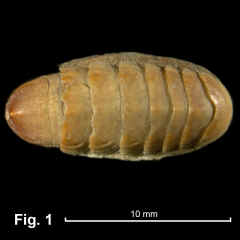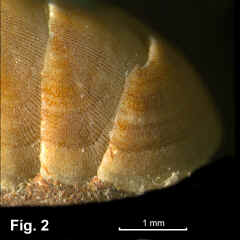|
|
LEPTOCHITONIDAE |
|
|
|
Parachiton puppis Hull, 1923 Description: Animal ovate, moderately elongate, girdle narrow. Median valves with central and lateral areas weakly differentiated; central area with rows of minute granules, longitudinal at the jugum, becoming radial towards the edge of the shell; lateral areas slightly raised with weaker transverse rows of granules. Girdle covered with round-topped striated scales. Posterior valve very long, mucro very near posterior edge. Colour white when alive, pale buff when dried. Size: Up to 16 mm in length. Distribution: Endemic to Australia. Known only from Sydney Harbour and Port Stephens, NSW and Nuyts Archipelago, SA. Habitat: The habitat of the holotype was given as "Under stone embedded in mud or soft sand, below low water mark". Very uncommon. Synonymy: Parachiton verconis Cotton & Weeding, 1939 is a previously recognised synonym based on a specimen from Nuyts Archipelago, SA. Remarks: The specimen shown in Figs. 1 and 2 is one of only three in the Australian Museum collection, in addition to the holotype. It is a dried specimen, with the girdle distorted and partly missing; the scales cannot be seen properly, and the girdle spicules mentioned by Kaas & van Belle (1985 p. 169) are not apparent. Fig. 1: Watsons Bay, Sydney Harbour. (Girdle dried and distorted and missing around posterior valve and valve out of position) (C.365177). Fig. 2: Detail of sculpture. Same specimen as Fig. 1. (Girdle dried and distorted, scales not apparent). |
|

